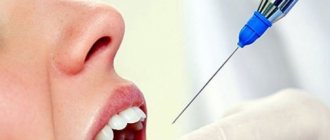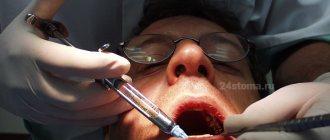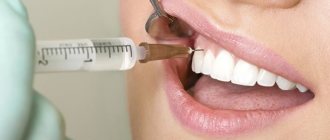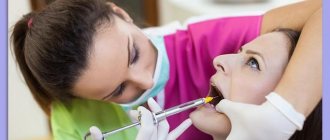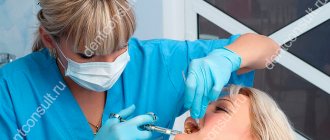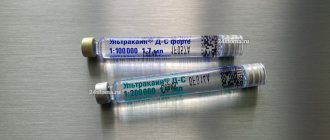Allergy to local anesthetics
Allergy to local anesthesia is extremely rare and in practice it is not possible to detect it using immunological tests.
The reaction to local anesthetics is pseudo-allergic in nature and is associated with the mechanism of degranulation of mast cells and basophils upon contact with Toll-like receptors on their surface. In terms of external manifestations, pseudoallergic reactions are no different from true intolerance to local anesthetics. They can be local or generalized. Appear on the second to fifth administration of the drug and are manifested by urticaria, edema, anaphylaxis or an attack of suffocation. The problem of modern medicine is related to the fact that reliable laboratory tests for determining pseudoallergic reactions have not been developed.
Much more often in practice there are allergies to anesthesia to additional components of the solution or packaging.
One of the leading places is occupied by latex allergy. Some manufacturing companies use latex to make pistons and plugs for glass cartridges. Doctor's gloves are also made from it. Therefore, if you have noticed a reaction to medical gloves, warn your doctor about it. The RuDenta clinic uses exclusively anesthetics in a cartridge with latex-free rubber.
Some manufacturers add stabilizers, preservatives and vasoconstrictors to the anesthesia solution.
Vasoconstrictors include adrenaline, norepinephrine and fellipressin. It is to these substances that we owe the strength and duration of anesthesia. They also prevent the rapid entry of the drug into the bloodstream and thereby reduce its toxic effect. However, there is also another side to the coin. They are oxidized too quickly by atmospheric oxygen. Therefore, sodium bisulfite must be added to their solutions. It reacts more actively with oxygen and thus prevents the oxidation of active substances. Bisulfites can cause allergic reactions and bronchospasm, more so in patients with hypersensitivity to sulfur-containing drugs (bronchial asthma). In such cases, the drugs of choice will be similar anesthetics without a vasostrictor: mepivacaine (Scandonest, mepivastezin) or ultracaine D.
An allergy to local anesthesia can develop to parabens , a preservative for drugs in ampoules and in some carpule anesthetics (Ultracaine D-S). Parabens are widely used in the food industry and in toothpastes.
Types of allergic reactions
In medicine, it is customary to divide allergic reactions into two main types.
- A drug allergy is characterized by a person’s rejection of a particular medicine, including those used in dentistry. Most often, patients in dental offices experience an allergic reaction to anesthetics or the components they contain. This happens less frequently when using teeth whitening products. Typically, the reaction occurs when the drug is injected or comes into contact with the oral mucosa.
- The contact type of allergic reaction is characterized by the fact that it does not appear immediately. A truly allergic reaction occurs after a critical mass of a substance accumulates in the body. In dentistry, this type of allergic reaction sometimes occurs from wearing plastic dentures for a long time and even from metal crowns. Less commonly, this occurs from filling materials.
Prevention
– anamnesis should be carefully collected in order to identify allergic reactions, recording their presence in the outpatient dental health record; if necessary, refer the patient for consultation to an allergy center to test the tolerance of local anesthetic drugs; – having determined the type of allergy, you should not use the substances that cause it; – patients suffering from various allergic and infectious-allergic diseases (rheumatism, collagenosis, bronchial asthma, eczema, etc.) should deserve special attention; – if it is necessary to use premedication, then it is advisable to introduce antihistamines (suprastin, tavegil, diphenhydramine), and in some cases hormonal agents (prednisolone, hydrocortisone); – carefully approach the choice of local anesthetics, taking into account not only the main active ingredient, but also the preservatives included in their composition (parabens, sodium bisulfite and their concentration); – in exceptional cases, when a polyvalent allergy to all local anesthetic drugs has been identified, it can be recommended to carry out anesthesia, after adequate premedication, with a 1% solution of suprastin or diphenhydramine in a volume of up to 3 ml. The effectiveness of anesthesia with these drugs is similar to anesthesia performed with a 1% solution of novocaine without a vasoconstrictor.
Measurement of activation markers and cytokines
After antigenic stimulation, T cells express activation markers such as CD25, CD69, CD40L, CD71, HLA-Dr, which can be measured by flow cytometry or immunofluorescence using specific monoclonal antibodies. There are a few studies that mention their use for drug allergies [34, 35].
Since delayed reactions to drugs are characterized by the appearance of sensitized T lymphocytes, other methods may be used to determine the immune response:
measurement of the level of lymphocytes expressing chemokine receptors (CCR4, CCR7, CCR10) is carried out by flow cytometry and immunohistochemistry. A number of authors have shown their role in T-cell inflammation of the skin [36];
determination of cytokines IL-2, IL-5, IL-13, interferon-gamma by flow cytometry and ELISA. The authors showed the high diagnostic significance of these methods (75% and 79%, respectively) [37, 38]. Cytokines can also be determined in supernatants using the ELISpot method, which is similar to ELISA;
determination of cytotoxicity of T-lymphocytes and natural killer cells. Cytotoxic proteases (granzyme B and granulysin) are determined. Immunohistochemistry and ELISpot methods are used. Low sensitivity has been proven in patients with DRESS syndrome, but higher sensitivity in Stevens-Johnson syndrome and toxicepidermal necrolysis [39]. Some authors propose the determination of skin lymphocyte-associated antigen by cytoflowmetry [40];
determination of transcription proteins (c-maf, GATA3, T-bet, STATs, p38MARK using polymerase chain reaction and flow cytometry [41].
Currently, only genetic markers can be considered prognostic methods, as, for example, shown for some ethnic groups in relation to certain drugs (abacavir, carbamazepine, dapsone and allopurinol) [42, 43]. However, genetic correlations with allergy to LA have not yet been identified.
Thus, most of the described methods for laboratory diagnosis of drug allergy to MA, with the exception of the determination of specific IgE and IgG and BAT, are so far available only to research laboratories.
Allergy symptoms in dentistry
A drug allergy manifests itself in the form of skin lesions or urticaria.
With a contact type of allergy, swelling of the oral mucosa occurs, itching, burning, and even stomatitis may occur.
The most severe manifestation of an allergic reaction in dentistry is anaphylactic shock. Initially, a person feels a slight tingling sensation on the skin of the face, later there is general weakness and, finally, severe pain in the chest area. Inaction in this situation can result in death for the patient, since the likelihood of swelling of the airways in this case is quite high. In addition, severe heart failure and seizures may occur.
How are skin tests performed?
The test is performed by an experienced allergist-immunologist on patients over 3 years of age. The study lasts 2.5 hours. During testing, the doctor administers an increasing dose of local anesthetic while closely monitoring the patient's condition. The final doses of the drug are the same as during dental surgery.
- To avoid false negative results, the doctor administers only those drugs that do not contain vasoconstrictors;
- The medications used for testing do not contain preservatives, which often cause allergies;
- The patient receives test results on the day of treatment;
- If a provocative test with a local anesthetic is negative, then the risk of side effects of the drug is minimal.
Expert opinion
Roman Borisovich Alekperov
orthopedic dentist
Experience: 24 years
As a rule, an allergic reaction does not always occur immediately after the installation of a crown or prosthesis. It can appear even after several years of use. It happens that when altering old structures with new ones, a reaction such as burning and swelling of the gums occurs. It seems that a person wore metal-ceramic crowns or a prosthesis for many years, got new ones, and six months later severe allergic manifestations began. Of course, to prevent such a development of events, it would be good to check with an allergist before getting prosthetics and take tests for sensitivity to dental materials. And then, new teeth, a new smile will give you pleasure, and not a headache and searching for the cause of poor health all your life. If you have the financial opportunity, it is better to immediately install crowns or prostheses made of zirconium dioxide. Hypoallergenic material. Take care of yourself and be healthy!
First aid
Every dental office should have an “emergency anti-shock” first aid kit, which includes:
- prednisolone;
- antihistamine;
- adrenalin;
- aminophylline;
- diphenhydramine;
- syringes;
- ethanol;
- cotton wool;
- gauze;
- tourniquet;
- venous catheter;
- physiological solution in a standard container of 400 milliliters.
Standard course of action for an allergic reaction: isolation of the irritant; use of antihistamines; prevention.
In case of a reaction to the prosthesis, it is necessary to replace the latter and prevent it with antihistamines (tablets, gels, ointments are allowed).
It would be useful to sanitize the oral cavity and follow a diet excluding chocolate, seafood, citrus fruits and other allergenic products from the diet.
All information should be recorded in the patient's medical record and updated as new information becomes available.
Allergies from dentures - myth or reality?
Prosthetics are an excellent chance to restore lost teeth or correct aesthetic defects. There are contraindications for installing crowns and dentures. These include allergic reactions of the patient to the dental material used.
Denture allergies are not a myth. The problem is urgent and becoming quite global; a generation is growing with a reduced or incorrect, atopic response of the human immune system.
Allergic reactions very often occur to artificial crowns that are in the mouth. They mainly react to products made of metal, metal-ceramics, or more precisely, to one of the components of the alloy.
Causes of an allergic reaction
Unfortunately, some people are predisposed to allergic diseases from birth. Diseases of the vascular system may also be the cause.
A doctor’s mistake can also cause an allergic reaction in the patient. This often happens when the anesthetic dosage is incorrect.
The reason may also be the patient’s ignorance that his body does not accept a particular medicinal substance.
Sometimes an allergic reaction occurs due to wearing dentures that are too old and poor oral hygiene.
It is extremely rare that an allergic reaction occurs due to fear of dental intervention.
Symptoms of an allergic reaction to dentures
It is not difficult to recognize the signs of an allergy; in most cases, the clinical picture looks like this:
- The gums become hyperemic and swollen, and palpation causes pain.
- Severe itching of the mucous membrane.
- Depending on the individual characteristics of the body, either dry mouth or excessive salivation is possible.
- Rash around the mouth and other areas of the skin.
- Copious nasal discharge.
- It is extremely rare, but there is a possibility of developing angioedema, especially if superficial allergy symptoms are ignored for a long time.
